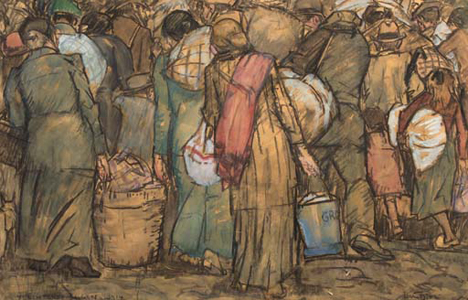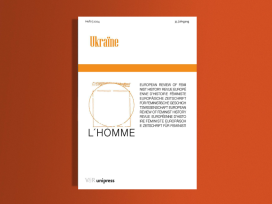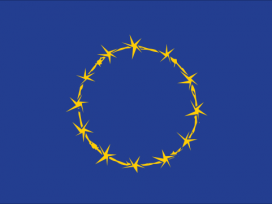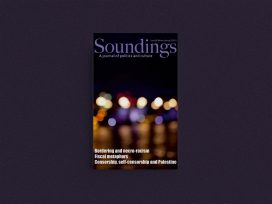For over a decade it has been possible to watch how, in Europe, national historical narratives have begun accommodating the history of migration. It is a long-drawn-out process, often beginning with a small group of enthusiasts and activists who deem the subject important enough to warrant wider public interest. Yet though the contemporary significance of the issue of minorities and migration generally cannot be avoided in mainstream European politics, the historical dimension generally takes second place. Despite the multitude of projects in the field of migration all across Europe, there continues to be a regrettable absence, for the most part, of two things. First, there is little or no historical depth to the narrative: migration is presented as something new and unprecedented, even though history offers a plethora of previous cases. Second, regional and national perspectives predominate at the expense of what could be a European narrative.

Leo Gestel “Belgians fleeing”. Photo: Christie’s. Source: Wikimedia
How, then, can migration become a fixed topic within the European narrative? For many Europeans, the combination of the words “migration” and “Europe” produces negative associations: they think of the EU’s external borders and an uncontrollable surge of Africans and eastern Europeans seeking work. Migration is perceived as an issue of the European present-day, indeed as a present-day European problem. The historical perspective is therefore already skewed due to the fact that little or nothing is known about it. Only very recently did the history of migration in Europe make its way into the schoolbooks. Since then, the topics of migration and integration have been treated in several different school subjects, but they feature least of all in history lessons. Why this reluctance to tackle the topic historically? To ask this question is to ask not only why the contemporary moment dominates the discussion, but also to ask what that means for migration’s place in a European narrative.
Moreover, which particular elements in the generally accepted narrative of European history offer the best starting-points for migration history? When the present-day narrative of Europe treats migration as a lurking threat (“Fortress Europe”), many Europeans with a conventional education think straight away of the Age of Migrations and of the “barbarian invasions” that heralded the collapse of the Roman Empire. Although a millennium-and-a-half separates then and now, the prevailing narrative of European history knows only a limited number of perspectives on this span of time, most of which are highly traditional. They always feature the history of struggles for territory, economic power and religious authority; wars remain a central feature of this version of history.
For some time now, however, the European historical narrative has been supplemented by social and economic developments, with the history of education and science, along with the gender perspective, also having made inroads. Migration history, on the other hand, not only gets overlooked, it seems to vanish altogether. When the only migrations taught are those of Late Antiquity and the present day, a narrow, stereotyped view of history threatens to emerge: that of migration as a potentially destructive and ungovernable process. What lies behind this narrative, where is it still taught and told, where is it challenged, and what are the prospects for an alternative?
Beyond an individual narrative of suffering
Popular knowledge of history draws on many and varied sources. In Europe, most people’s first contact with the prevalent historical narrative comes not only from television documentaries and school textbooks, but from the fictional representations of history found in historical novels, films or computer games. In many genres, it has meanwhile become difficult to distinguish clearly between documentary and fiction. On the other hand, it is no longer just the publishers of school textbooks who draw on the latest historical research – academic historians are also consulted in film productions, for example. School textbooks in Europe include a spectrum of topics that reflect a broad political consensus: something like a canon of facts that informs the citizen’s first conscious reflections on history, fixing certain key dates and core historical processes in the memory. This canon is either confirmed or challenged by the various forms of “public history”, be it on television, in museums and exhibitions, in literary works or in films with historical subjects.
However, because public history needs to draw an audience, the national historical perspective nevertheless continues to predominate: in order to attract visitors or viewers, it first needs to refer to prevalent narratives, after which it can pique their interest for new and unfamiliar material. Particularly television’s love of the didactics of emotion, be it horror or pity, tends to lead to concentration on a narrow range of historical topics. On television, migration history generally means the history of human suffering: our screens are dominated by images of poverty-stricken migrants, of refugees from wars, of population exchanges and ethnic cleansing. Nor is the choice of topics driven by didactic considerations alone; there are also aesthetic strictures. Film needs the moving image, and using archival footage can be a simple and cost-effective way to supply this need. However newsreel tends to record exceptional circumstances and often shocking events. Consequently, the televised narrative of European migration history is dominated by the twentieth century, with all its dramatic upheavals and displacements, invariably in a visual language that emphasizes the helplessness of the victims.
In the last fifteen years the museum has also become a dominant locus for conveying migration history. Objects from the past “speak” to visitors about their histories. In many recent exhibitions and museum designs, migration history has been told via individual life histories, or histories of ethnic groups, focusing on jobs and work, or on the places where the migrants finally settled, be it a city district or a region. Local perspectives and starting points do not, however, automatically exclude the possibility of a European narrative, any more than do the strictly national presentation of events in museums such as the Cité nationale de l’histoire de l’immigration in Paris, the Deutsches Auswanderhaus in Bremerhaven, which will soon feature immigration as well, the Immigrantmuseet in Copenhagen or the Population Exchange Museum in Catalca, Istanbul. The example of museums shows how a local or regional narrative perspective can stand for itself alone and at the same time be part of a wider trend across many nations.
The focus on the individual life story as window on migration is a conscious attempt to escape limiting perspectives on “peoples”, “ethnic groups”, religious groupings and nations. Individual anecdotes communicated via audio installation or digital archive are popular ways to indicate the bigger picture. Such a trend might become the core of a pluralist European narrative of migration in historical perspective. It is also, however, a convenient way to dodge the pitfalls that, when seen from a nationalist point of view, recent migration history in particular can present. Europeans still know little about their national migration histories, and even less about those of their neighbours; yet many have heard stories from older members of their family that call to mind the experience of migration. If this strand of individual memory could be woven into a historical background, it could become a European narrative; today, scholarly historical research on migration can provide that background.
Crossing history’s borders
While academic research has opened up new ground in migration history, popular media have been unwilling to follow. From the start, the historiography of migration has taken a comparative approach that required a supra-regional and international understanding. Historians concerned with economic migration, refugee movements and expulsions have had to cross borders between professional disciplines. In the 1930s, the French historians of the Annales school took the topic of trade to demonstrate the logical absurdity of a historiography limited by national borders, in a manner which was revolutionary at the time. The topic of migration is no less suited to such an approach, be it in the form of bi-national comparisons, the study of larger regions and their migration networks, or today’s popular global perspective on migration. The state’s eye-view of history has long been superseded, so that today historical terminology no longer talks of “immigration” or “emigration”, but simply of “migration”. By doing away with the prefixes, we show that we recognize how the choice to migrate is not irreversible, and that we recognize perceptions of the direction of migration as relative.
It was only in the 1990s that Europe became a significant category for historical migration research. The reason was primarily that there were now sufficient individual case studies to allow this broader geographical approach. However the shift was also stimulated by current events: the reunification of eastern and western Europe and what the popular media described as the “flood” of asylum seekers from outside Europe and refugees from the Balkan wars. The European perspective reveals several common trends in migration, from the massive departure of people from Ireland, German and Italy in the nineteenth century, through the Greek-Turkish “population exchanges” in 1922 and the expulsion of Germans from what became western Poland after the Second World War, to the recruitment drives of the 1950s and 1960s, which saw Europe’s industrialized north draw workers from the agrarian south. The more closely European integration leads to an all-encompassing “Europeanization”, the more closely we can discern the European dimensions of trends and processes in migration history. Precisely because of its geographical multi-perspectivity, migration history has become attractive; having been a marginal field, it has now entered mainstream historical research. Yet public awareness of the historical dimensions of migration in Europe continues to stagnate in widespread ignorance.
The House of European History
Which migration should become part of a European narrative? The question is not an easy one – the only uncontroversial instances are migrations that lie so far back in time that all can agree on their consequences for European history. It is much harder to agree about migration in recent history and the present, and even individual national historiographies have trouble with such cases. Whenever and wherever the consequences of migration are felt in the present, questions arise of minority rights, group rights, inequality and discrimination, and demand that any “official” history be politically correct.
Like any other public presentation of history, the House of European History in Brussels, due to open in 2014, will be unable to avoid taking a political stance on such questions. A good way to see how this “official” narrative of European history plans to include migration is to look at the report of its committee of experts, which summarizes European history in 108 sections. The topic of migration crops up in six of these sections – which, given the sweep of history that they present, is not bad. The permanent exhibition will focus on the twentieth century, so that migration history will mostly be presented in the forms it took during that period.
However, it is more important to ask where migration is absent in this narrative. Visitors are to be told about the great migrations of antiquity, about migration from the countryside to the cities during the industrial revolution, and about the refugees and displaced or expelled persons who migrated after both World Wars. This list does not mention the “international” aspects of seasonal migration in Early Modern Europe, a well-researched topic by now; nor does it mention the vast scale of emigration to the Americas from various European countries, or the substantial migration from outside Europe at the end of the colonial era. Even the workforce recruitment campaigns in the southern countries during Europe’s boom years in the 1950s and 1960s is omitted. Such large-scale historical processes have fallen victim to the necessary selection process, but they might perhaps be part of the section “Questions for Europe’s Future”, which aims to throw up questions for visitors to ponder. One of these is, “How can the EU react to the demographic change affecting all its member states? Is encouraging immigration an effective response?”
Ideally, then, what should be part of a European narrative? What are the “landmarks” of migration history that any serious account of European history should, on the basis of the current state of knowledge, include? Migration is better suited than any other topic to providing a European perspective on history: after all, every time cross-border migration occurs, a comparative analysis is required – and, if possible, a transnational one. To learn about the Tsarist Russia’s recruitment of German craftsmen is to understand Catherine the Great’s policy of expansion; to study the flight of the French Huguenots is to gain insight into religion and reformation in the Early Modern period; to observe the patterns of seasonal migration in the Alps or the Low Countries is to grasp the workings of Europe’s supra-regional economy. The industrial revolution and urbanization cannot be disentangled from geographical mobility among Europeans, while the individualization of migration, visible in late nineteenth-century emigration to America, yields important insights about social shifts in the industrial age. When religious minorities were persecuted all across Europe, often with considerable violence, but when they also found in Europe places of shelter, then a tension emerges between discrimination and tolerance that may be typically European.
None of these movements can be understood without some measure of historical knowledge – which is exactly why migration history encourages us to look for more information and to expand our own understanding of history. Many of the processes of migration are especially well suited as an appetizer for a deeper engagement with history, since they take the fates of individuals as their starting point but then feed into a larger narrative that creates a desire to learn more about the larger underlying historical context.
Pitfalls and painful histories
Histories of individual or collective economic migration can be easily be used in appeals for greater tolerance, openness, mutual recognition and respect – and so run the risk of becoming platitudinous. Yet migration history also contains issues such as political inequality between a migrant’s country of origin and her destination, or the topics of forced migration and discrimination – which can trip up the unwary. As a result, engaging with the topic of migration will not always lead to a constructive debate.
The absence of a historical perspective on migration can be explained with reference to tendencies in the politics of historiography. Migration history is potentially controversial where a national narrative, founded in the nineteenth century, insists on an identity founded on excluding the Other; it is controversial as a narrative of how political discrimination established hierarchies of need and reward. Importantly, the story of the past and its migrations can also offend international loyalties, whenever shifting borders and the formation of new states have forced people to move. One example of this process is the interminable stand-off between German and Polish organizations, leading over the years to intergovernmental negotiation, centred around the foundation of a Centre against Expulsion (Zentrum gegen Vertreibung) that would focus on the topics of refugees, expulsion and resettlement programs in central and eastern Europe before and after the Second World War. Another example is discussion in France about the integration of the pied noirs after Algerian independence in 1962. In such cases, past events meet with astonishment among the general public, since up until now they had been discussed and recounted only in parallel narratives. The existence of such parallel narratives is, however, a pan-European phenomenon, one that should be included in any European narrative of migration history.
This is perhaps the most important characteristic of European migration history, for in the final analysis it is the desire for national integrity that has made it so difficult for European countries to accept and address all facets of their own migration history. National integrity is a typical preoccupation for modern Europe. Even our history of peaceful economic and political collaboration in Europe since the Second World War can do little to change this; indeed, international politics finds itself faced with a demand for political correctness, which has a similar effect on the European migration history narrative. The public face of history mirrors political considerations, and certain priorities are established to the detriment of migration history. Gaps arise in our knowledge, and are perpetuated. Thus the rich and varied history of European migration fails to feature in Europe’s history lessons.
The proportion of the population born (quite by chance) in a particular territory have always formed the majority, while it was the minorities, the outnumbered, who arrived or departed. Often enough, such movements were not voluntary, but took place against a background of violence; in many instances, poverty and deprivation were the causes for migration. What would happen if Europe were to have a two thousand year experience of migration, discrimination and exclusion that nobody today remembered? What is certain is that, throughout history, Europeans have been highly mobile – certainly much more mobile than modern Europeans believe.








